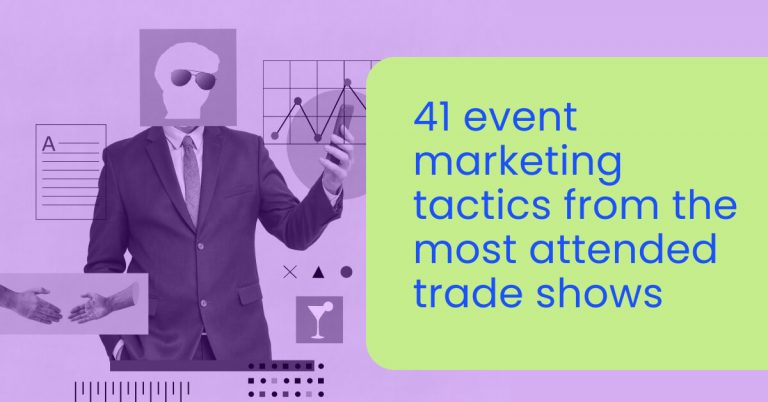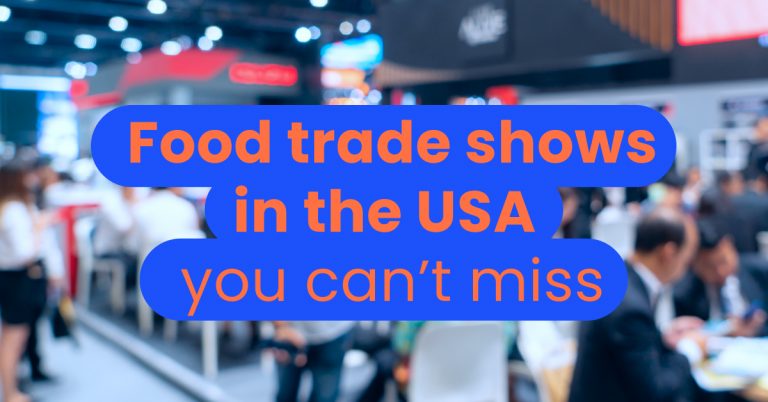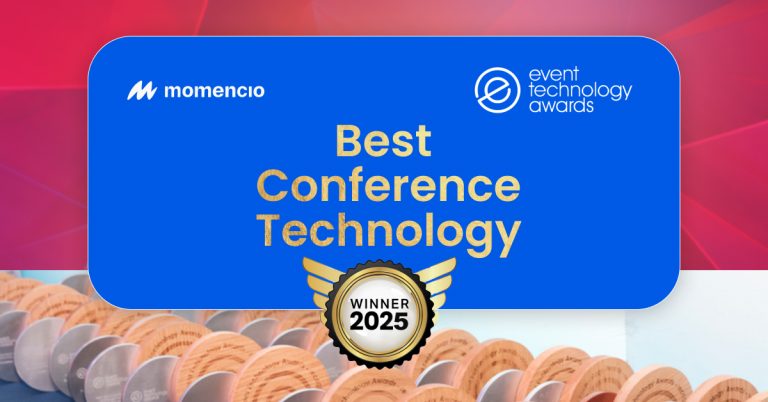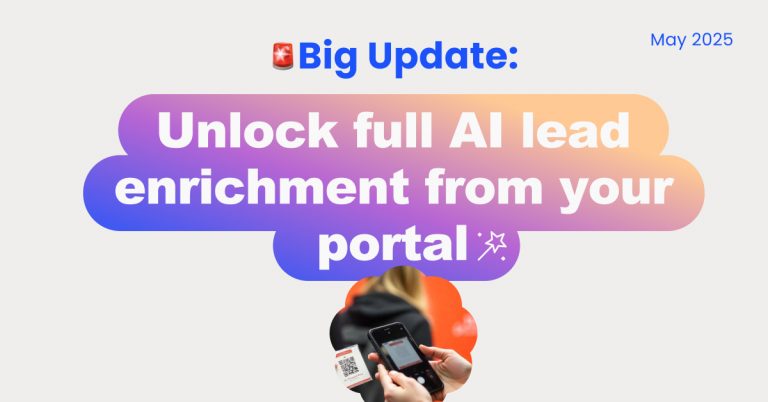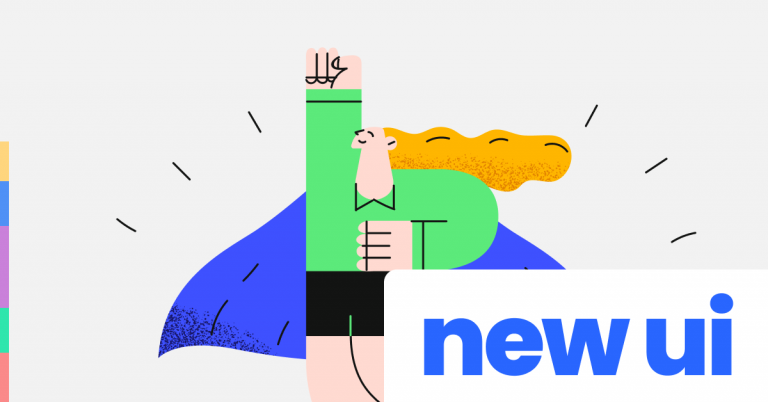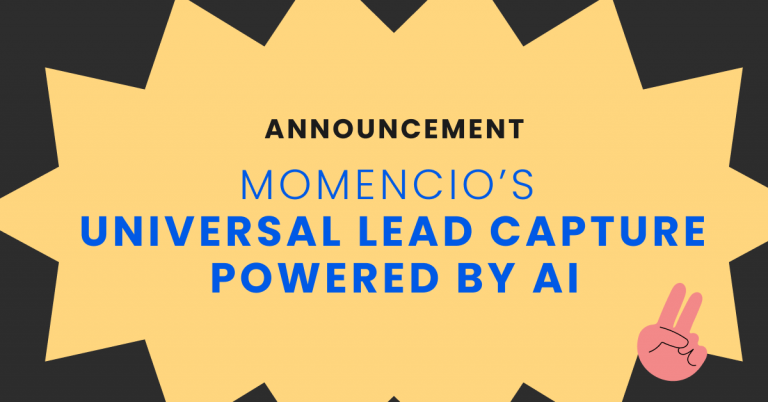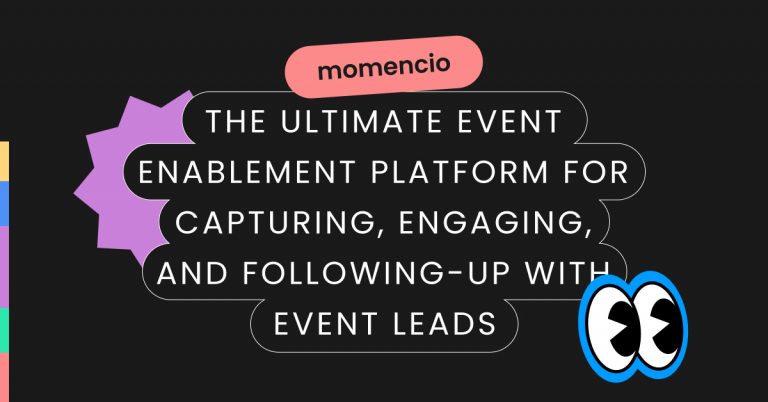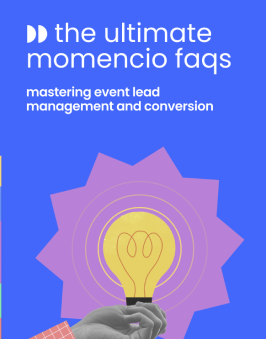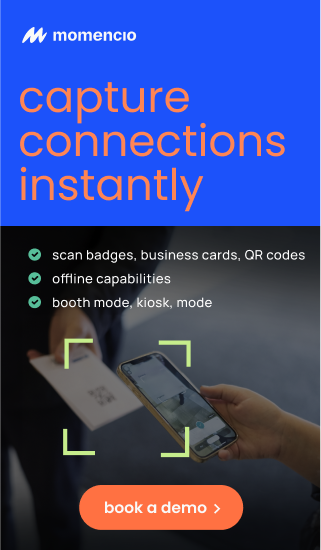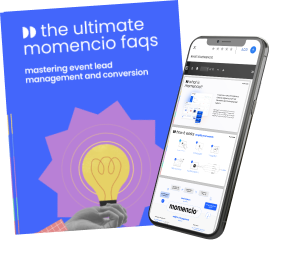Introduction
Lead-chasing at a trade show event is a waste of time. Despite the common belief that more leads mean more sales, the numbers don’t lie—80% of trade show event leads are never followed up on. This means wasted resources, time, and energy on contacts that do not convert.
The key to trade show event success is not gathering hundreds of unqualified leads—it’s about meaningful engagement. High-value interactions are what lead to conversions, and modern trade show event strategy needs to reflect that.
This guide will cover how to ditch the outdated practice of chasing leads and shift to an engagement-first approach that actually delivers results.
The Hidden Cost of Chasing Leads: The ROI-Killer
Traditional lead-chasing at trade show events is like throwing darts in the dark.
You might hit a few targets, but the majority will miss. What most businesses don’t realize is that time spent chasing unqualified leads costs more than just time—it drags down your overall ROI. The cost of following up with cold, unengaged leads, not to mention the resources poured into managing them, is a drain. These are contacts who may have stopped by your booth out of curiosity but had no real buying intent.
The solution? Shift from a lead volume mentality to a lead quality focus. Stop measuring success by the number of business cards collected or scanned and start evaluating how many high-potential conversations you had with genuinely engaged prospects.
What to do?
Focus on interaction and engagement metrics, not just lead count. Track how long attendees engage at your booth or with your marketing collaterals and the depth of their interest, so you know who’sactually worth following up with. Quality always outpaces quantity.
Build Pre-Show Momentum: Engagement Begins Before the Event
Most trade show event exhibitors fail long before the event even starts. Why? They rely solely on the event itself to generate leads, overlooking the crucial opportunity to build interest in advance.
Why wait until attendees are flooded with booths and pitches to make your first impression? By engaging them early, you ensure they come to the show with you already on their radar.
Tactical Pre-Event Steps:
- Segment and Personalize
Use data from your CRM or event registration to identify the key attendees you want to target. Start personalized outreach weeks before the event, using email campaigns, social media, and even personalized direct mail to pique their interest.
- Targeted Ads and Landing Pages
Run paid social campaigns that push attendees toward a customized landing page featuring key sessions or demos your company is hosting. Make it easy for them to add it to their schedule.
- Exclusive Invitations
Invite top prospects to an exclusive demo, VIP experience, or networking event, just like you extend a luncheon invitation to your VIP prospects. By creating a tailored experience just for them, you build a stronger bond and increase the likelihood of engagement at the event.
Remember: Pre-show marketing isn’t a nice-to-have—it’s essential for optimizing booth traffic and maximizing lead engagement during the event.
Designing for Interaction: Stop Pitching, Start Engaging
If your trade show event booth still revolves around handing out brochures and pitching to passersby, you’re losing. Today’s attendees are bombarded with information from every corner of the trade show event floor. To cut through the noise, you need to offer something different—an experience.
Booth design isn’t just about looking good; it’s about creating a space that draws people in and keeps them engaged. Statistics show that companies that use interactive experiences and gamification can increase attendee satisfaction by up to 33%.
Key Booth Engagement Strategies:
- Augmented Reality Demos
AR allows you to create immersive product demos, letting attendees experience your product in a more engaging way. This doesn’t just capture attention—it builds memorability.
Introduce gamified elements that engage visitors. Whether it’s a trivia contest or an interactive quiz, these activities encourage participation and give attendees a reason to stay longer at your booth. In turn, you can track participation, ascertain which activities garner the most attention for agile event management, and use real-time data to prioritize leads and customize post-event communication.
- Interactive Touchscreens
Allow attendees to explore your products or services at their own pace by curating your sales and marketing collaterals on personalized microsites for each lead in real-time. People are more likely to engage when they can control the experience themselves.
Remember: Stop relying on pitches and start creating interactive experiences that attendees will remember. The longer they stay engaged, the warmer the lead becomes.
Real-Time Engagement Is the Game-Changer
Timing is everything. Leads that are engaged within five minutes of initial interest are 100x more likely to be contacted and converted. The biggest missed opportunity at trade show events? Real-time engagement.
Too many companies rely on passive lead collection, waiting until after the event to follow up. But by then, the lead is cold, and their interest has faded. Instead, smart exhibitors use real-time tools to engage attendees while their interest is at its peak.
Tactical Steps for Real-Time Engagement:
- Leverage Mobile Event Apps
Equip your team with mobile apps that allow them to scan badges, track booth visitors, and get real-time insights into who’s showing the most interest. Apps like momencio let you capture visitor data instantly, providing actionable information on-the-fly.
- Tailored Engagement
Use real-time data to adjust your approach. If a visitor shows interest in a particular product, tailor your conversation to that product and send them customized content immediately.
- Instant Feedback
Real-time feedback collection tools allow you to capture attendee reactions instantly. Use that data to refine your pitch during the event, optimizing your engagement approach on the spot.
Remember: Real-time engagement isn’t just a strategy—it’s a necessity. When you engage prospects while they’re still interested, you significantly increase your chances of conversion.
Post-Event Lead Nurturing Is Where the Real Wins Happen
The event might end, but the real battle for conversion starts afterward. 40% of exhibitors wait three to five days after a trade show event to follow up with their leads, drastically reducing the likelihood of a successful conversion.
To win post-event, your follow-up strategy needs to be timely, personalized, and data driven. It’s not just about sending a generic “thank you” email—it’s about continuing the conversation you started at the event.
Tactical Follow-Up Plan:
- Segment Leads by Engagement
Not all leads are created equal. Use event data to segment leads based on their level of engagement. High-interest leads should receive immediate follow-up with highly personalized content.
- Automate, but Personalize
Set up automated email workflows, but ensure they’re segmented and personalized based on the interactions that took place at the event. Leads that receive tailored content are 6x more likely to engage.
- Send Personalized Microsites
Instead of sending generic follow-up emails, create microsites tailored to the interests the lead showed during the event. Include videos, testimonials, and additional resources that match the attendee’s profile.
Remember: Post-event follow-up is where most companies drop the ball. By automating the process and using personalized, segmented outreach, you drastically improve your chances of conversion.
10 Trade Show Event Follow-Up Myths Debunked
Trade show event success doesn’t end when the event closes. The real work happens in the follow-up. Yet so many companies fall victim to outdated beliefs about how to nurture leads post-event. Here are 10 common myths, debunked by hard facts that will help you turn leads into clients more efficiently.
Myths |
Facts |
| Myth #1: It’s okay to follow up in a week. | Fact: Businesses reaching out to leads within an hour are seven times more likely to connect with decision-makers. |
| Myth #2: Send the same follow-up to everyone. | Fact: Personalized follow-up emails increase click-through rates by 139%. |
| Myth #3: Follow-up emails should be long and detailed. | Fact: Concise emails perform better. A clear, snappy email with 50–125 words can boost your response rate by over 50%. Less is more—focus on value, not volume. |
| Myth #4: High lead volume means success. | Fact: It’s about lead quality, not quantity. Approximately 82% of trade show event attendees are directly involved in making purchasing decisions. |
| Myth #5: All trade show event leads are equal. | Fact: Not all leads are worth the same effort. Hot leads from real-time booth interactions should be followed up first. |
| Myth #6: Manual follow-ups are best. | Fact: Automation isn’t impersonal—it’s essential. Lead scoring automation boosts lead generation by 77% and sales productivity by 79%. |
| Myth #7: More follow-ups increase conversion. | Fact: Timing is more important than frequency. Lead contact success drops 10 times after one hour. |
| Myth #8: Phone calls outperform email follow-ups. | Fact: Email follow-ups convert better in the initial stages. 80% of successful sales take five or more follow-up calls, while the first follow-up email can increase reply rates by an impressive 49%. |
| Myth #9: A generic post-event thank you email works. | Fact: Thank you emails fall flat. Prospects are 6x more likely to engage if they receive a personalized follow-up based on their interests. |
| Myth #10: Waiting a few days shows you’re not pushy. | Fact: Speed matters. Real-time follow-up within hours of the event is key. Leads that receive immediate responses are 100x more likely to convert. |
TL; DR: Trade show event leads go cold fast. Follow up within 24 hours, personalize every interaction, and get real-time feedback to stay ahead. Make data-driven decisions that optimize every single lead.
The Psychology Behind Booth Design: Turn Engagement into Leads
Trade show event success isn’t just about having a flashy booth—it’s about using design psychology to guide behavior, increase interaction, and generate high-quality leads. Here’s how you can leverage psychological principles to design booths that do the heavy lifting for you.
Cognitive Load Theory: Less is More
Overloading visitors with too much information results in cognitive burnout. Keep it simple. Design your booth to minimize distractions and focus on one or two clear messages. Attendees process information faster and are more likely to engage when they aren’t overwhelmed.
- What to do: Use clean layouts, clear visuals, and interactive touchpoints that let attendees explore at their own pace. Avoid clutter—everything should have a purpose.
Reciprocity: Give First to Get
People are hardwired to reciprocate when they receive something valuable. This creates a natural flow of interaction. Offer something meaningful before asking for their time. This could be a demo, an exclusive content piece, or even a personalized experience.
- What to do: Move away from traditional printed collateral. Share digital presentations with prospects on-demand. These on-demand presentations should be accessible online, making it convenient for them to revisit and engage with your content even after the event. The more personalized the offer, the stronger the reciprocity effect.
Social Proof: People Follow the Crowd
Attendees are more likely to engage with your booth if they see others interacting with it. Make engagement highly visible. Use leaderboards, real-time results, or interactive group experiences to showcase social proof.
- What to do: Incorporate interactive experiences and gamification so that visitors can not only learn more about your offerings in real time but also help you understand their preferences and behaviors.
Scarcity: Limited-Time Offers Drive Action
Fear of missing out (FOMO) is a powerful motivator. Limited-time offers create urgency. Create scarcity by offering something exclusive that’s only available during the trade show event or for a limited time.
- What to do: Promote exclusive show deals or private product previews that attendees can’t get after the event. Display a countdown or scarcity message to drive action.
Authority: Be the Expert in the Room
People trust authority. Position your booth as the go-to place for expert insights. Leverage authority by sharing exclusive data or hosting interactive quizzes and surveys with industry leaders.
- What to do: Have key experts at your booth who can speak authoritatively on your industry and your product’s value. Incorporate data-driven content like research or benchmarks to establish your credibility.
Remember: Design psychology isn’t just theory—it’s your secret weapon. Use these principles to build a booth that draws visitors in and keeps them engaged, leading to better-qualified leads and higher conversion rates.
Vanity Metrics Are Killing Your ROI—Here’s What to Track Instead
Tracking the wrong metrics is like running on a treadmill: lots of movement, but you’re going nowhere. Here’s what you’re doing wrong, and more importantly, what you should be doing instead to drive real trade show event success.
What You’re Doing Wrong |
What You Should Do Instead |
| Leads Collected: Tracking how many business cards you’ve grabbed feels good, but it’s a shallow metric. It doesn’t tell you anything about lead quality or intent. | Engagement Duration: Time at your booth is gold. The longer a visitor engages, the more invested they are. Use event apps to track time spent at demos and prioritize follow-up for longer engagements. |
| Booth Traffic Volume: Focusing on sheer foot traffic is like chasing views on social media. It’s noise. How many meaningful interactions happened? | Content Interaction: Measure which content (videos, demos, AR experiences) had the most engagement. People interacting with your content are more likely to convert. Event engagement tracking tools can show exactly where attention went. |
| Business Cards Collected: Think handing out a stack of business cards means success? Think again. Most cards end up in a drawer (or worse, the trash). | Lead Scoring Based on Behavior: Use lead scoring tools to rank leads based on their actions on your collaterals. Did they engage with key demos? Watch customer testimonial videos? Interact with specific content? Focus on scoring better results. |
| Email Open Rates: Focusing solely on how many people opened your follow-up email? Open rates don’t close deals. | Post-Event Engagement Rates: Track how many leads actually respond or interact with follow-up materials. Responses, not just opens, show true engagement. Personalize the follow-up for a higher success rate. |
| Total Leads Generated: Generating a big lead list is impressive, but how many of those are real buyers? Lead lists can be bloated with low-quality names. | Revenue Per Lead: The only metric that really matters: how much revenue are these leads driving? Calculate the ROI of your trade show event efforts based on the revenue each lead brings in over time. Use sales analytics to track this. |
Remember: If you’re measuring leads collected or booth traffic volume, you’re stuck in the past. Start tracking engagement duration and revenue per lead to get real trade show ROI. The rest is just noise.
Proven Trade Show Event Strategies You’re Overlooking (But Shouldn’t Be)
Success at trade show events doesn’t come from the basics—it’s the advanced strategies that most companies ignore. Here are advanced tactics that will set you apart and deliver measurable results.
#DidYouKnow: Personalized microsites can drive post-event conversions up by 50%.
Forget generic follow-up emails. Attendees respond to personalized content, and microsites are a high-performing way to do that.
- What It Is: A microsite is a dedicated, tailored landing page for each lead based on their interaction at your booth.
- How It Works: After their interaction at your booth, you send each qualified lead a link to a personalized microsite featuring the products and other relevant marketing collaterals they engaged with. Include videos, whitepapers, and a tailored CTA to book a personalized demo to keep their interest high.
#DidYouKnow: Gamified Lead Scoring Boosts Engagement by 100%
Gamification isn’t just for consumer brands—it’s a powerful trade show event tool.
- What It Is: Gamified lead scoring assigns points to each action visitors take at your booth, from attending a demo to participating in a quiz or survey. Visitors with higher scores are more likely to convert.
- How It Works: Use tools that track visitor actions and award points for deeper engagement. Display real-time leaderboards to create friendly competition among booth visitors.
#DidYouKnow: Real-Time Interactive Surveys Can Increase Conversions by 30%
Stop guessing what your attendees want—ask them on the spot.
- What It Is: A real-time interactive survey captures instant feedback from attendees during their booth visit, driving strategic decision-making.
- How It Works: Attendees answer tailored questions that align with your event’s themes and objectives, helping you gather meaningful insights. The data can inform your follow-up approach instantly.
#DidYouKnow: Hyper-Segmented Pre-Show Targeting Can Increase Booth Traffic by 34%
It’s not just about what happens at the event—pre-show targeting is critical.
- What It Is: Hyper-segmented pre-show targeting uses data to create ultra-specific marketing messages aimed at key attendee groups before the event.
- How It Works: Identify high-value targets from your CRM or event registration list and send tailored invitations to visit your booth or attend exclusive demos. Use personalized messaging to get them invested before they even step foot in the venue.
#DidYouKnow: Exclusive VIP Experiences Can Elevate Your Brand Above the Noise
Make prospects feel special, and they’ll make your brand their priority.
- What It Is: A VIP experience is an invite-only event for top prospects. It could be a product preview, private demo, or exclusive networking event.
- How It Works: Identify your highest-potential leads before the event and invite them to an exclusive experience—either during the show or at a post-event gathering.
Remember: It’s not the basics that win trade show events—it’s the advanced strategies like personalized microsites, gamified lead scoring, and VIP experiences. Start implementing these tactics to turn engagement into real revenue.
FAQs
- What’s the best way to engage attendees at a trade show event?
- The key is personalization. Start by identifying your target audience before the event and use tailored messaging to draw them in. Once they’re at your booth, engage them with interactive elements like augmented reality demos, gamification, or personalized experiences. Remember, engagement isn’t about a sales pitch—it’s about creating memorable, meaningful interactions that make attendees want to learn more.
- How do I convert booth traffic into qualified leads?
- Not all booth visitors are created equal. The best way to convert traffic into qualified leads is by lead scoring based on real-time engagement. Sales and event enablement platforms like momencio can track the specific actions visitors take at your booth (e.g., how long they stay, which demos they interact with). Focus on the leads that show the highest engagement, then tailor your follow-up based on their specific behaviors and interests.
- What tools should I use to measure trade show event success?
- Stop measuring vanity metrics like total leads gathered or business cards collected. Instead, use tools that track engagement time, content interaction, and post-event follow-up success. Platforms like momencio integrate with your CRM and offer real-time analytics, helping you assess not just how many leads you collected, but the quality of each interaction and how likely those leads are to convert.
- How do I improve post-event lead nurturing?
- Timing and personalization are everything. Follow up within 24 hours of the event with a personalized email or a customized microsite that reflects their interactions at your booth. Automated, personalized workflows through your CRM can keep leads engaged over time, nurturing them with targeted content until they’re ready to convert. The more relevant the follow-up, the higher your chances of closing.
- What metrics are essential for calculating trade show event ROI?
- Beyond basic lead count, focus on metrics that reveal actual engagement and business impact. Track engagement duration, post-event interactions, and—most importantly—revenue per lead. Tools like event apps and CRM integration platforms can give you real-time insights into how much value each lead brings to your pipeline, letting you calculate the true ROI of the event.



